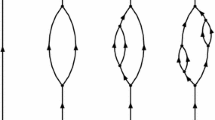Abstract
We propose a simple method for the approximation of the integrand in the integral representation of the free energy of a system of particles with two-particle interactions admitting a Fourier expansion, based on which the equation of state of a with a double exponential potential liquid is obtained without laborious calculations. The found temperature dependences of the equilibrium thermodynamic properties appropriately describe the corresponding experimental data. The effectiveness of the approach is demonstrated on the example of a model with double Yukawa potential.






Similar content being viewed by others
REFERENCES
Baxter, R.J., Exactly Solved Models in Statistical Mechanics, New York: Academic, 1982.
Kas, M., Uhlenbeck, G.E. and Hemmer, P.C., J. Math. Phys., 1963, vol. 4, p. 216.
Lieb, E.H. and Fa Yuen Wu, in Phase Transitions and Critical Phenomena, vol. 1: Exact Results, Domb, C. and Green, M.S., Eds., New York: Academic, 1972.
Lin, Y.-Z., Li, Y.-G., and Lu, J.-F., Mol. Phys., 2004, vol. 102, no. 1, p. 63.
Guerin, H., Phys. A (Amsterdam, Neth.), 2002, vol. 304, p. 327.
Khedr, M. Bahaa., Osman, S.M., and Al Busaidi, M.S., Phys. Chem. Liq., 2009, vol. 47, no. 3, p. 237.
Kasimov, N.S., Ukr. Fiz. Zh., 1988, vol. 33, no. 11, p. 1666.
Kasimov, N.S., Ukr. Fiz. Zh., 1984, vol. 29, no. 9, p. 1327.
Heyes, R. and Rickayzen, G., J. Phys.: Condens. Matter, 2007, vol. 19, 416101.
Zakharov, A.Yu. and Loktionov, I.K., Theor. Math. Phys., 1999, vol. 119, no. 1, p. 532.
Zubarev, D.N., Dokl. Akad. Nauk SSSR, 1954, vol. 35, no. 4, p. 757.
Zakharov, A.Yu., Phys. Lett. A, 1990, vol. 147, nos. 7–8, p. 442.
Loktionov, I.K., High Temp., 2011, vol. 49, no. 4, 512.
Loktionov, I.K., High Temp., 2012, vol. 50, no. 6, p. 708.
Loktionov, I.K., High Temp., 2014, vol. 52, no. 6, p. 390.
Loktionov, I.K., High Temp., 2019, vol. 57, no. 5, p. 648.
Ruelle, D., Statistical Mechanics: Rigorous Results, London: Imperial College Press, 1969.
Baus, M. and Tejero, C.F., Equilibrium Statistical Physics: Phases of Matter and Phase Transitions, Brussels: Springer, 2008.
Stewart, R.B. and Jacobsen, R.T., J. Phys. Chem. Ref. Data, 1989, vol. 18, no. 2, p. 639.
Landolt-Börnstein: Zahlenwerte und Funktionen aus Physik, Chemie, Astronomie, Geophysik und Technik, Heidelberg: Springer, 2013, vol. 2, part 4, p. 757.
ACKNOWLEDGMENTS
The author expresses his sincere gratitude to Professor A.Yu. Zakharov for helpful advice, valuable comments, and discussion of the results of the article.
Author information
Authors and Affiliations
Corresponding author
Additional information
Translated by L. Trubitsyna
APPENDIX
APPENDIX
To prove the inequality
in which 0 < D < 1, 0 < d < 1, D < d, in region G1, x > 0, let us consider the function
where 0 ≤ ν ≤ 1, p > 0.
Differentiating function (23) twice with respect to ν, we get
It follows from this equation that the curve φ(ν) is concave, and, since φ(0) = φ(1) = 0, then φ(ν) < 0 at 0 < ν < 1, or, as follows from (23):
By assuming in (24) ν = D/d and p = xd, we arrive at the inequality
Taking the logarithm of (25), we obtain inequality (22), from which inequality (9) follows. In conclusion, it should be noted that the values used in the proof, ν = 0 (D = 0) and ν = 1 (d = 1), correspond to the upper and lower boundaries of the region G1; however, the actual values of δ and ε are contained inside G1, where D ∈ (0; 1) and d ∈ (0; 1).
Rights and permissions
About this article
Cite this article
Loktionov, I.K. Equation of State for a Liquid with Double Exponential Potential. High Temp 59, 184–191 (2021). https://doi.org/10.1134/S0018151X21020073
Received:
Revised:
Accepted:
Published:
Issue Date:
DOI: https://doi.org/10.1134/S0018151X21020073



